
Saving energy in the workplace can make a big difference in reducing your carbon footprint. With how much time we spend at work, our workplace is just as important as home when it comes to healthy indoor air quality, comfort, and overall atmosphere.
Studies have shown that having a green office increases cognitive functioning and productivity—so taking steps to make your office a little greener is truly a win-win. “Ecologic and economic goals should be and can be aligned. Anything else is to profit now at the expense of future generations,” says Sander Geelen, managing director of Geelen Counterflow, the family-owned manufacturing business headquartered in a sustainable, green office in the Netherlands.
The Outlook of Human Centric Lighting
1. Use Daylighting
Healthy, efficient lighting is important for every workplace. However, all too often office lighting is just an afterthought. Lighting with heavy glare hurts your eyes, leading to strain, and work hours feel even longer. But sustainable, user-friendly lighting solutions can reduce a workplace’s energy needs and increase worker happiness levels.
For optimal health, people need their circadian rhythms to reset every day—daylighting and human-centric circadian lighting is essential to that process. Daylighting is the strategy of placing windows, or other apertures and reflective surfaces, so natural light provides internal lighting during the day. This building strategy also lessens a building’s overall energy usage.
Marty Brennan, project architect and daylighting specialist at ZGF Architects, suggests a dose of blue light in the morning and switching the light to a redder hue as the day goes on. “From an evolutionary standpoint, we evolved outside,” he says. That’s why it makes sense for our bodies to be aligned with the natural cycles of day and night.
 Tunable LED lighting is a perfect way to create circadian lighting. [Photo: Benjamin Benschneider Photography]
Tunable LED lighting is a perfect way to create circadian lighting. [Photo: Benjamin Benschneider Photography]
One workspace that blends together integrative lighting strategies like circadian lighting and daylighting is Atlas Workbase, a coworking space based in Seattle. The project focused on health and wellness, ergonomics, and, incorporating natural lighting, says Marti Hoffer, CEO of lumenomics, a natural lighting design firm.
With only one wall to provide natural outdoor light, it was a challenge to infuse daylighting, so Hoffer and her team had to get creative. Roller shade systems let in natural light, lighting controls adjust brightness to suit every worker’s needs, and spectrum-enhanced task lighting aligns with circadian rhythms and boosts energy savings.
"Investing in light and user-friendly controls from day one affords so much ability to manage occupant comfort and productivity,” Hoffer says. If the glare becomes too harsh from the windows, workers can easily adjust the window coverings. Deeper into the coworking space, the conference rooms feature a luminous ceiling that mimics sunlight. Also, customizable lighting options are available in all 50 coworking subspaces—every room dims or brightens based on the time of day, programmed schedules, or room occupancy.
“People tell us every day, ‘I’ve never had a more productive day of work,’” says Bill Sechter, Atlas Workbase CEO and cofounder. “Because we invested in the health and wellness and client experience of our members, lighting has really added to Atlas Workbase and our experience here.”
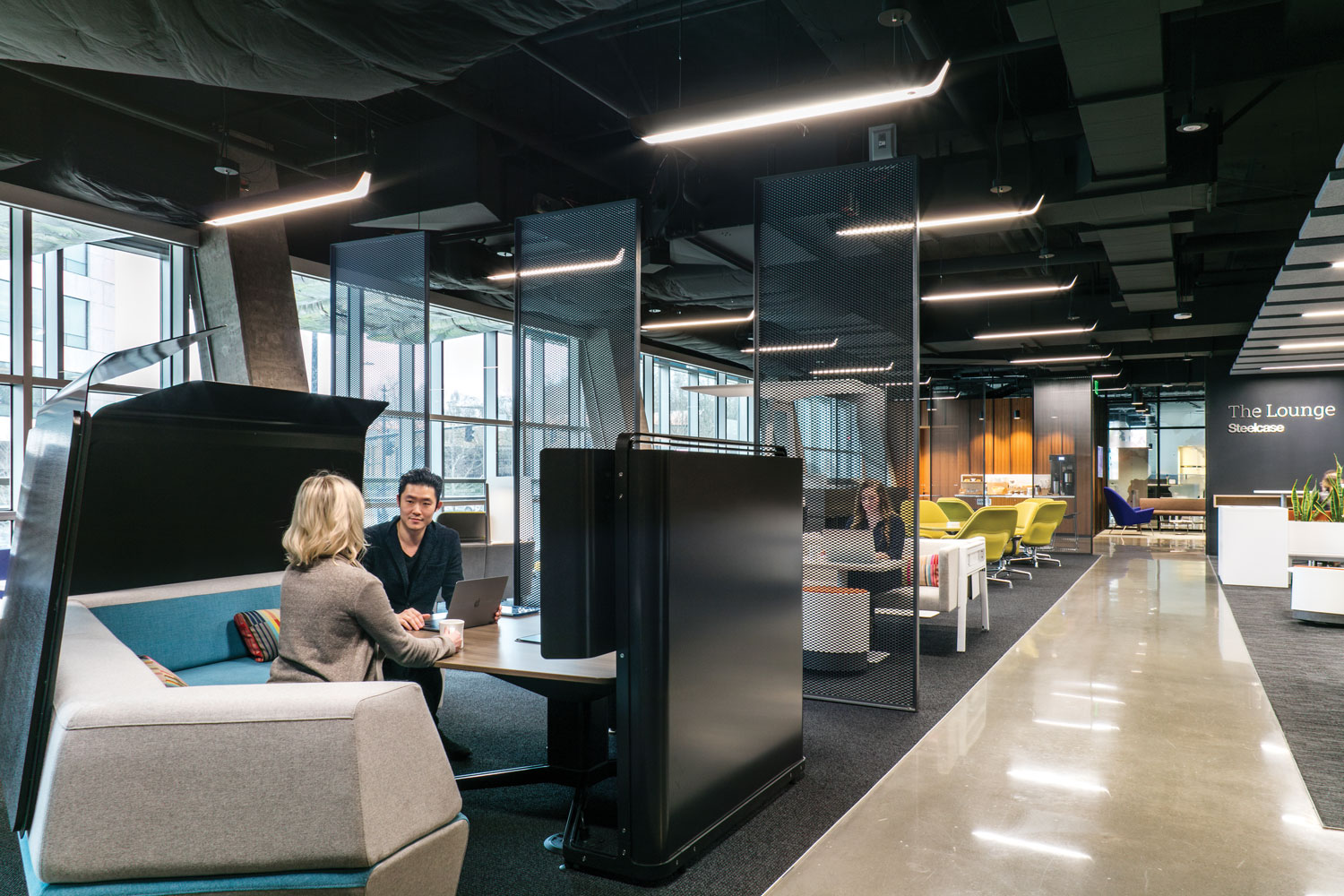
Atlas Workbase, a coworking space in Seattle, features flexible and sustainable lighting solutions. [Photo: Courtesy of Gensler]
2. Improve IAQ
Indoor air quality (IAQ) has a major impact on cognitive performance, according to Harvard University research. The researchers found that cognitive function scores were significantly higher under green building conditions compared to conventional building environments.
“We have been ignoring the 90%. We spend 90% of our time indoors and 90% of the cost of a building are the occupants, yet indoor environmental quality and its impact on health and productivity are often an afterthought,” says Joseph Allen, lead author of the Harvard University study. “These results suggest that even modest improvements to indoor environmental quality may have a profound impact on the decision-making performance of workers.”
Cognitive Scores in Green vs. Conventional Offices
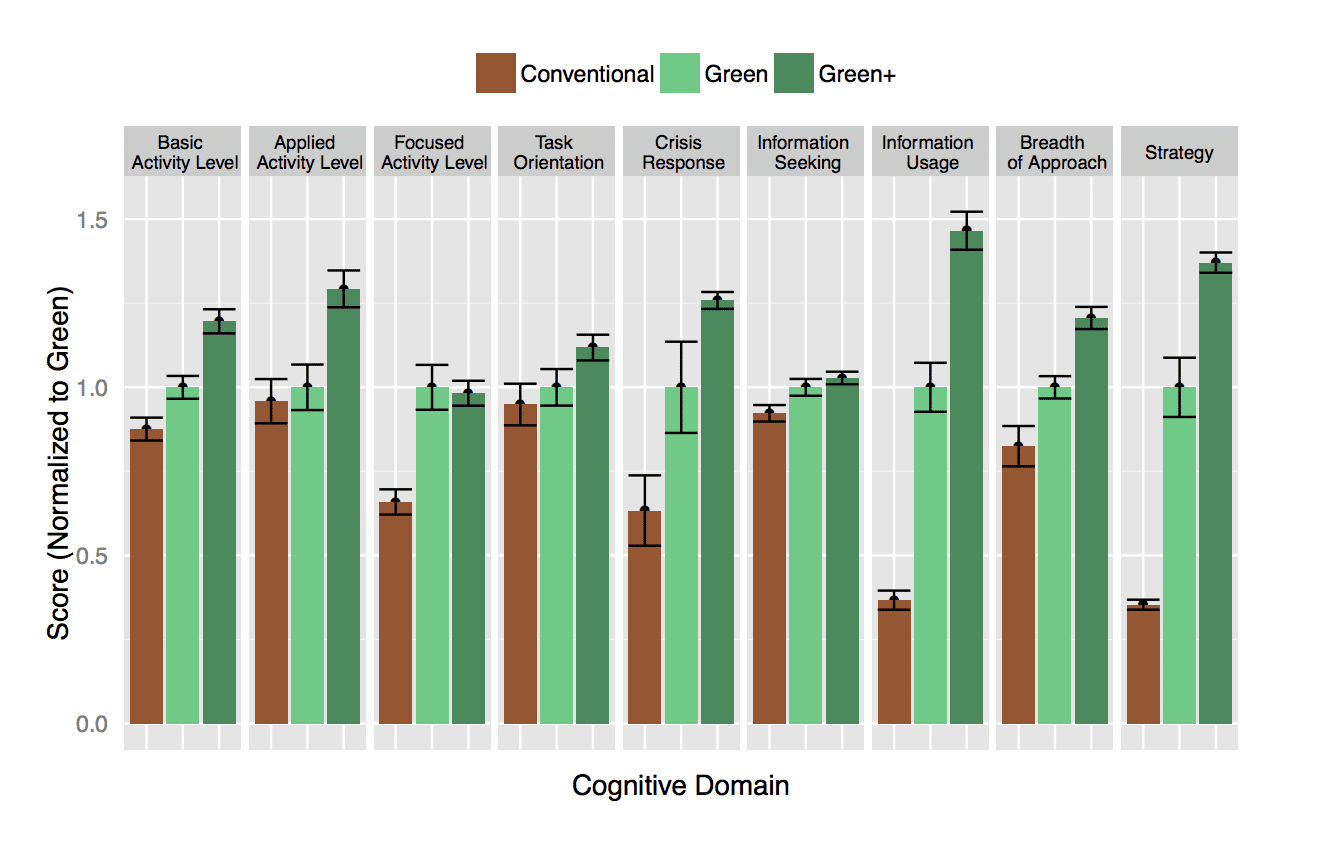
[Source: Environmental Health Perspectives]
Research conducted by the EPA has shown that indoor environments sometimes have higher levels of pollutants than outdoor environments. Indoor air pollutants can cause a range of health problems, especially for those with asthma. Many EPA studies and independent scientific panels have consistently ranked poor IAQ as a significant environmental health issue. The EPA also estimates that indoor air pollution costs the U.S. tens of billions of dollars every year in lost productivity and medical expenses.
So, for better productivity, it’s important to make sure an office building has healthy air quality. But what steps can you take? Because IAQ is constantly changing, it’s important to take all factors into account, including the sources of pollutants, HVAC systems, moisture, and humidity. The EPA recommends three main strategies for managing IAQ: removing the pollutants from the building, diluting pollutants through effective ventilation, and filtering the air to make it healthier.
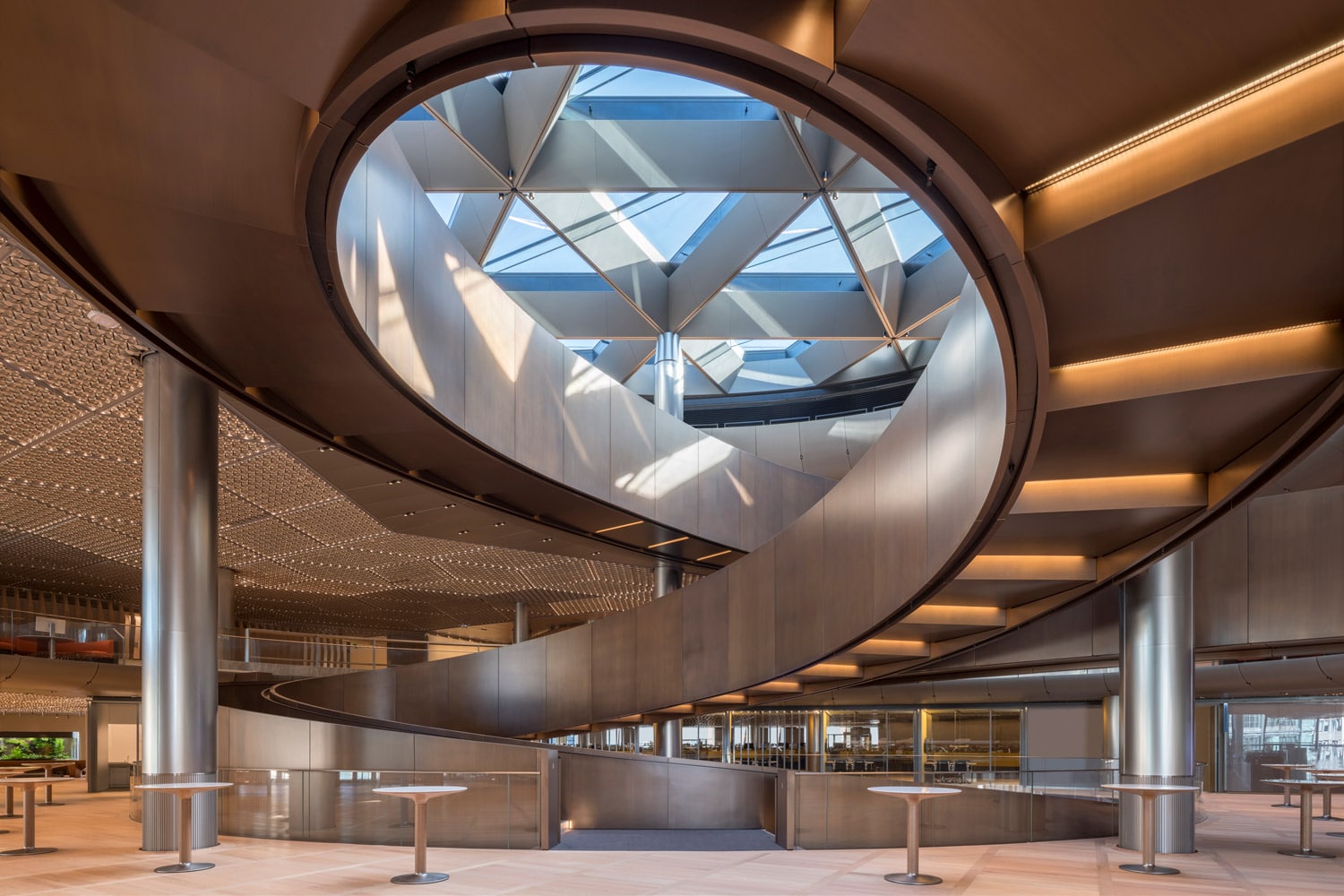
Bloomberg’s new European headquarters in the heart of London includes ample natural lighting and ventilation. [Photo: Nigel Young / Foster+Partners]
Another way to improve IAQ is to use an integrated strategy that brings all team members together at the beginning of the office design process—from interior designers to mechanical engineers. This way, the teams can define IAQ goals from the start and take these objectives into account when they select materials and mechanical systems. Design collaboration can help reduce off-gassing and other airborne contaminants. The Red List by the International Living Future Institute (ILFI) is a helpful resource for weeding out products that have toxic, harmful chemicals.
Bloomberg’s new European headquarters in London, often referred to as the most sustainable office in the world, uses carbon dioxide-detecting controls that enhance IAQ and change airflow based on the office’s occupancy. The outside of the building adds to the workplace’s natural ventilation system, too. The building exterior has “breathable” finned walls that open and close based on the weather.
“People respond better to environments that change, that ebb and flow with the temperature and sounds and light,” says Michael Jones, the project architect and senior partner at Foster+Partners. “The breathable walls are like opening a window at home. You feel better. It’s the same kind of effect on a much larger scale.”
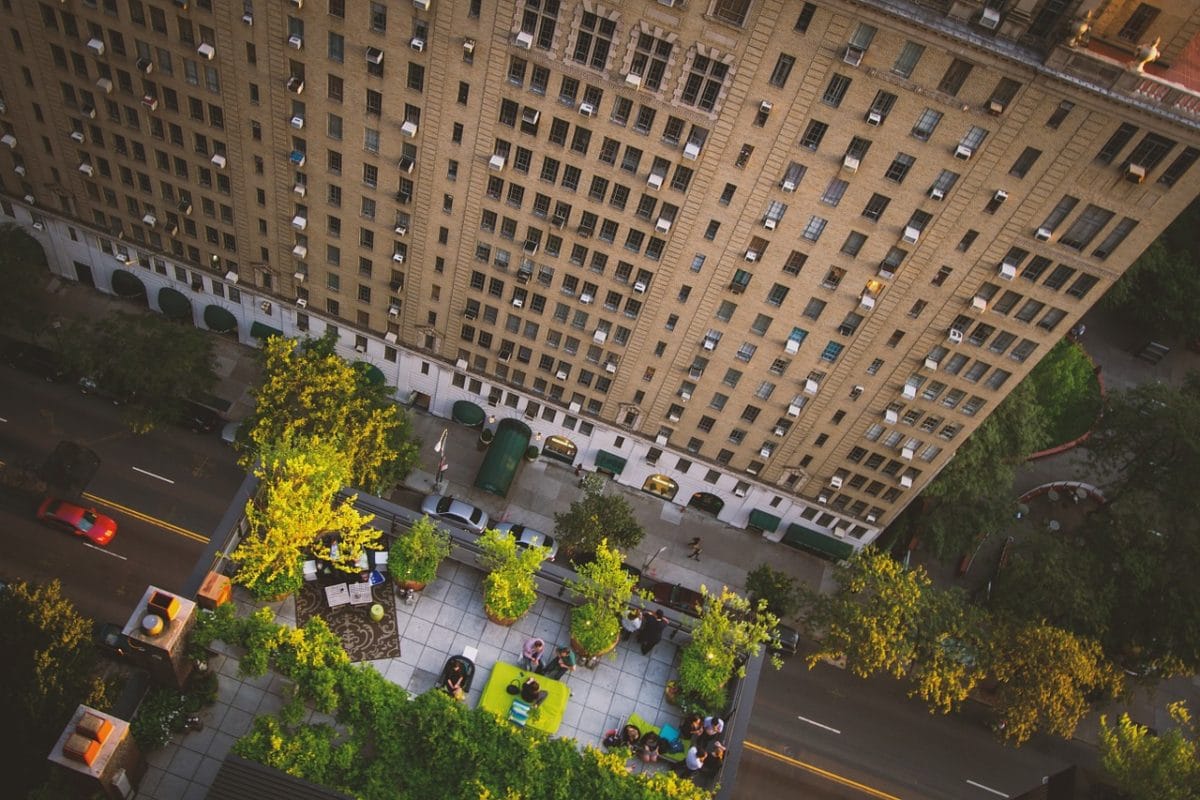
The natural benefits of green roofs are countless—from managing stormwater to cooling down your building. [Photo: Unsplash]
3. Consider a Green Roof
Green roof systems, also known as living roofs, can make your green office even more sustainable. Besides the aesthetic allure of a green roof, living roof systems are also cost-effective and full of natural benefits. Green roofs can be built on top of virtually any building, and offer several advantages over conventional roofs.
Roofs have tremendous heat loss in the winter and extremely hot temperatures in the summer. Fortunately, green roofs help mitigate weather issues by keeping the heat in and the cold out. It’s no wonder that green roofs have been around since the Viking Age since sod acts as a natural insulator.

[Source: "Green Roofs in the New York Metropolitan Region, Research Report," Rosenzweig]
Green roofs can also help manage abundant stormwater runoff. They act as sponges by soaking up water and delaying the runoff flow. Green roofs naturally filter the excess water, keeping pollutants at bay.
Living roofs also cool down your workplace—green roofs reduce heat by absorbing excess sunlight. By lowering the heat transfer through the roof, green roofs reduce heat discomfort brought on by heat waves. They are especially beneficial in large cities where dark surfaces are common. Urban environments are usually hotter than rural areas because of the heat island effect, which leads to high energy costs for air conditioning and other mechanical systems. Because green roofs absorb heat and insulate your building, your office doesn’t need to rely as much on HVAC equipment. Vegetation also removes air pollutants, like dust and smog particles.

A green roof can help boost health and wellness and provide the perfect place to unwind. [Photo: Courtesy of Architek]
A green roof could become the new staff hangout. Green roofs help improve your overall wellness by boosting your energy levels and brightening your mood. They provide a green space to unwind and escape from the daily grind. Some green roof systems are used to grow fruits and vegetables, or to create natural relaxation zones for the workplace. Incorporating a green roof in your office could also help reduce noise pollution since green roofs absorb more sound than hard surfaces.
Maintaining a green roof is actually less expensive than a traditional roof because green roofs are more durable—in the end, they offer a return on investment that conventional roofs cannot compete with. “If green roofs are done extremely well, they’ll protect the building. They last three or four times as long as normal roofs,” says Ron Schwenger, principal at Architek, a leading living architecture distributor based in British Columbia.

This Netherlands office combines greenery and natural light to achieve biophilic design. [Photo: Courtesy of Geelen]
4. Incorporate Biophilic Design
Integrating elements of biophilic design can also make your office environment greener. Work settings with daylighting, natural ventilation, and other features that reflect the natural world lead to better performance, lower stress, and higher motivation.
The evolution of biophilic design started long ago—humans have been building shelters in response to their climate and cultures for thousands of years. Most conventional buildings are designed with cost as the main factor. Other elements, such as energy efficiency, aesthetics, and material selections are taken into account as well. But biophilic design takes it a step further to see how design decisions can encourage occupant well-being by fostering a connection with nature.
“Biophilic design is ultimately about making happier, healthier spaces where both people and nature can thrive,” says Amanda Sturgeon, CEO of ILFI.
Stephen Kellert, a biophilic design pioneer and prolific writer on the subject,describes the myriad elements of biophilic design and why humans are drawn to natural design attributes—from the inclusion of plants in workspaces to scenic views of nature. An office filled with plants enhances comfort and well-being, helping workers feel more at peace. Kellert says contact with nature has been linked to better cognitive performance on tasks that require concentration and memory.
The new Etsy headquarters in Brooklyn is the perfect example of how biophilic design can enhance the workplace. Employees have a direct connection with nature through a plethora of indoor plants, landscaped terraces, green walls, and green workspace dividers. A 3,000-gallon rainwater collection tank provides water for all of the office’s living architecture. “The project embraced the Living Building Challenge benchmark as an opportunity to instigate change in the building industry and to set a new standard for sustainable construction and design,” says David Briefel, sustainability director at the collaborative design firm Gensler.
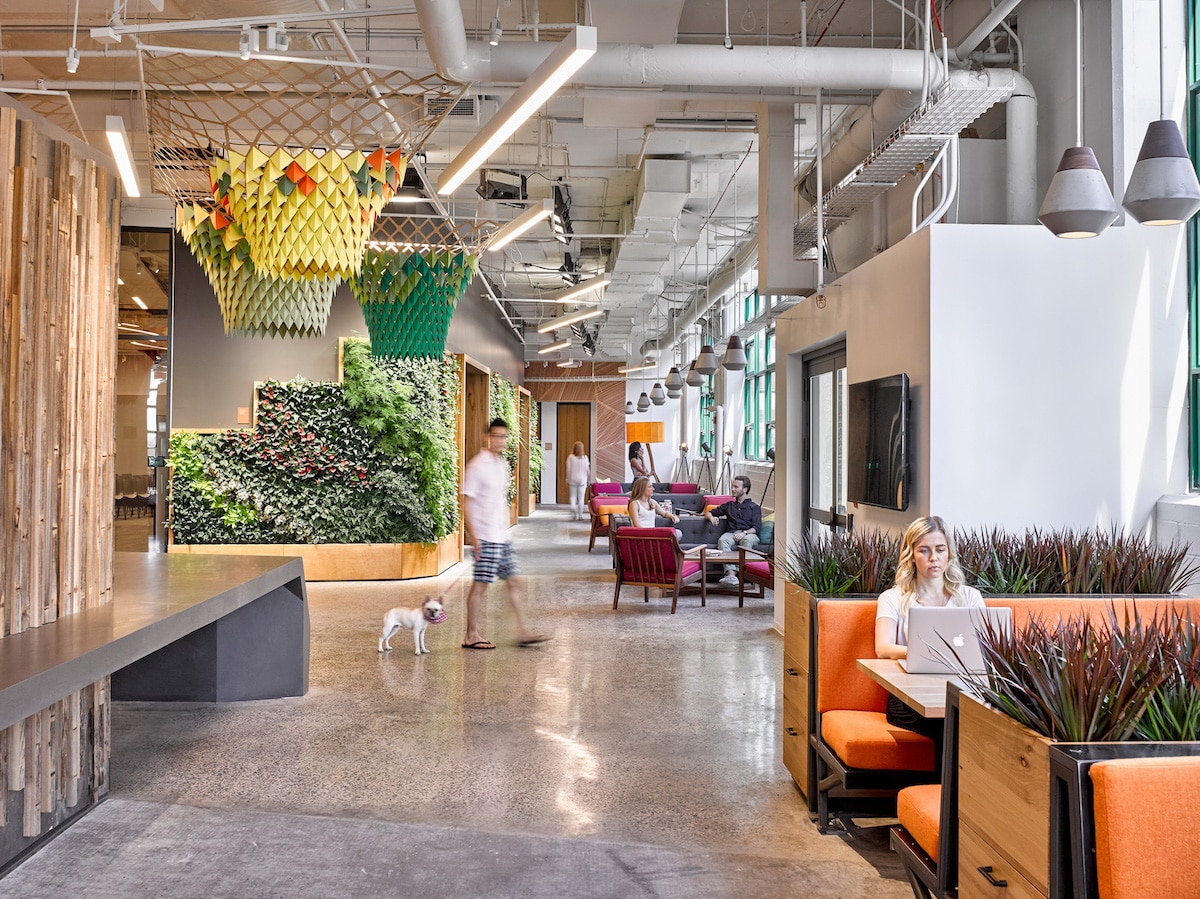
Etsy employees work in a creative environment that incorporates inspiring biophilic design. [Photo: Garrett Rowland, Gensler]
Biophilic design is core framework for ILFI’s Living Building Challenge(LBC). Instead of a checklist of best practices, the LBC encourages designers to think of holistic solutions by providing a series of performance goals. The certification framework is divided into seven performance categories called Petals: place, water, energy, health + happiness, materials, equity, and beauty. The LBC inspires green builders to create projects that are regenerative spaces, self-sufficient, healthy, and beautiful.
“As building occupants, we’re drawn to spaces that interact with nature. But often we’re left with spaces that don’t give us that choice, ones with no windows, no fresh air or views of anything other than a wall or parking lot,” Sturgeon says. “With today’s increased focus on the health and wellness of buildings, now is the time to achieve biophilic design.”
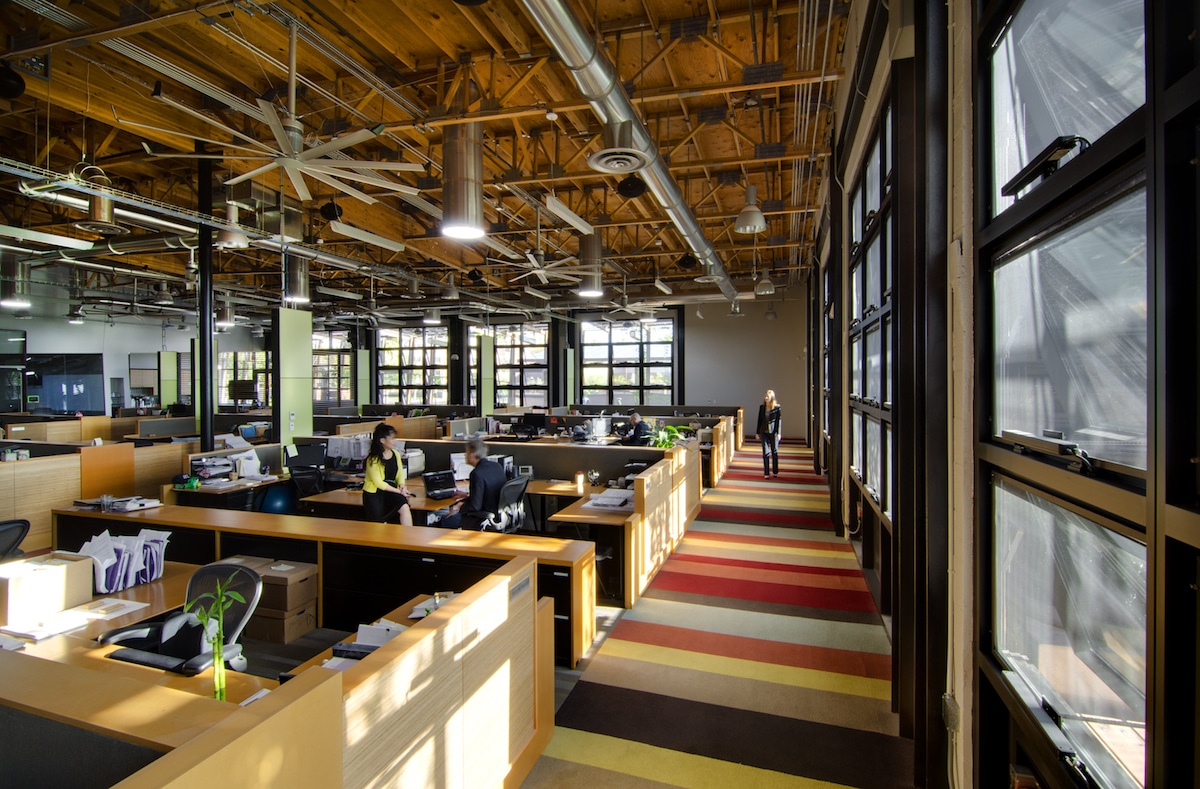
HVLS fans are quiet and cool—they help make your office a more comfortable place to work. [Photo: Gregg Mastorakos]
5. Install an HVLS Fan
Everyone has been in an office building with thick, still air lacking circulation. It’s definitely not the ideal environment for productivity. Luckily, there’s a solution. High-volume low-speed (HVLS) fans create comfortable, energy-efficient office environments. The subtle air movement is reminiscent of being outdoors—it’s like feeling a breeze.
Oddly enough, HVLS fans were originally used to cool livestock in dairy barns. “HVLS fans didn’t exist before the year 2000. They’re a relatively recent invention,” says Richard Hoofard, the director of engineering for Entrematic, the manufacturer of commercial HVLS fans designed to fit seamlessly into their surroundings.
HVLS fans are more cost-effective and energy-efficient than conventional fans and HVAC systems. They work well in standard office settings—like a lobby or large call center with rows of cubicles. The efficient fans are the perfect addition to provide cool air without going overboard on extra costs or energy waste. HVLS fans combine well with other cooling systems and prevent you from running the AC full blast, saving both energy and money.
Air Flow Pattern for HVLS Fans
[Source: MacroAir]
Data collected from the American Society of Heating, Refrigeration and Air Conditioning Engineers shows that buildings have saved as much as 49% with HVLS fans. HVLS fans are a year-round solution for better climate control. Using HVLS fans blends the air in your office to boost the comfort at the ground level and reduce heat loss during the winter.
More than seven feet in diameter, HVLS fans rely on their size instead of speed to circulate large amounts of air. By installing an HVLS fan in your workplace, you can easily reduce your energy consumption by setting your thermostat a little higher and using the fan to diffuse the cool air.
When TSP designed The Hub, a student commons building at the Southeast Technical Institute in South Dakota, the team knew they wanted to incorporate HVLS fans in the space. “The ceiling heights are really tall, so the fans help destratify the air at the top of the ceiling,” says Michelle L. Klobassa, a principal at TSP. Also, HVLS fans are quiet and cool, which is another perk for the workplace where excess noise can be a major distraction. Under regular operating conditions, you can’t hear them at all—so, you’ll be saving energy without even realizing it.
- Filed Under: Green Facilities
- ( 17196 ) views

Green Building & Design (gb&d) is a trade magazine that connects and inspires green building professionals by partnering with those at the forefront of sustainable design. Our print magazine and dynamic online edition offer a global perspective on new projects and products created with sustainability and social responsibility in mind.
- ( 0 ) Ratings
- ( 0 ) Discussions
- ( 0 ) Group Posts
Reply/Leave a Comment (You must be logged in to leave a comment)
Connect with us!
Subscribe to our monthly newsletter:




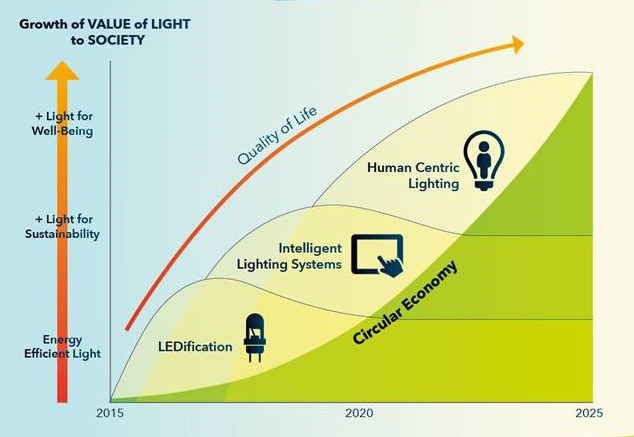

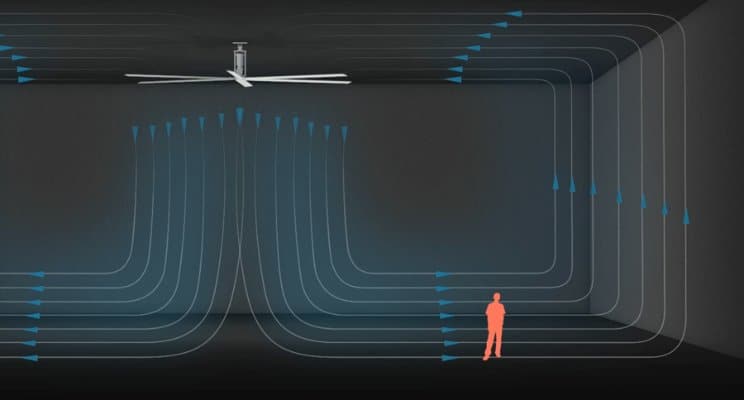


























Not a Member Yet? Register and Join the Community | Log in